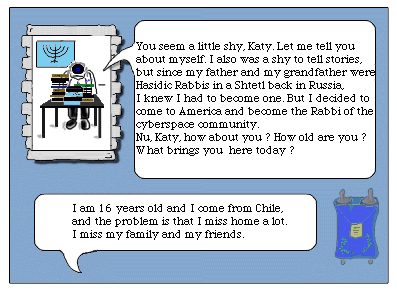

"Rabbi Grois" constructs his "personae" through the different conversational turns in order to set a socio-cultural context without limiting the interaction and breaking expectations. It uses Ydische words and a language that presents himself as a Hasidic Rabbi and gives to the user contextual information about his family story, his age, his actual job. For example, as presenting himself as an old rabbi who is becoming deaf, he maintains the suspension of disbelief when the parser fails to parse user's input.
To construct a believable Rabbi I revisited my experience in the Jewish community in Argentina and interviewed Rabbi Posner, from Boston, and an expert on Jewish storytelling, Moshe Waldoks. Both of them gave me interesting insights on the appropriate language used by American rabbis and on the dynamics of the conversation.
The seven phases of the interaction do not represent the exact model of the sequence followed in the "Yehidut" (interview between Rebbe and Hasid -discipule-) but respect the spirit of the encounter and the characteristics that are universal to other counseling through storytelling experiences. For a detailed study on Hasidism, see "Spiritual Intimacy. A study of Counseling in Hasidism" by Zalman Meshullam Schachter-Shalomi.
The Hasidic Stories used by the system have been taken from: